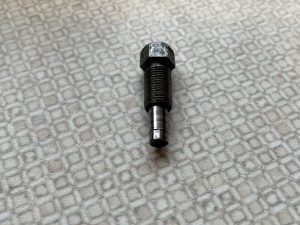One of our section members brought this to my attention, so I thought it might be worth posting about it.
He was completing the rebuild of his late fifties Matchless G3LS when he discovered that although there was plenty of oil circulating and returning to the oil tank, he had none feeding up the long pipe to the rocker box and therefore the top of the engine.
He’d checked the obvious things, such as blocked pipes, worn oil pump and leaky end cover joints at each end of the oil pump. After looking at the oil pump guide pin more closely, he noticed some wear on the end of the pin, along with a small flat.
Once the guide pin was replaced, oil flow was quickly restored to the top of the engine.
I wonder how many people are running their bikes with worn guide pins…or pumps…and the resulting poor oil flow? It does actually mention the problem in the workshop manual: ‘Oil feed to rocker box cut off (all single cylinder engines). If the rocker box feed pipe is unobstructed, examine the end of the pump guide pin for wear. A flat worn on this pin will cut off the oil supply to the rocker gear.’
This is the sort of problem that can creep up on you…I’ve ordered three new pins from AMC Classic Spares and will be checking my guide pins over the winter.
Whilst you are inspecting your oil pump, it might be an idea to check the position of the oil pump plunger. These bikes are quite prone to wet sumping…a manual tap often being needed. I came across a note on a forum that suggested bringing your engine up to compression, then setting the oil pump plunger so that it was as far back in the oil pump hole as possible, i.e. minimal gap between the plunger and the rear cover plate. This ensures the input port is covered and minimises wet sumping.
